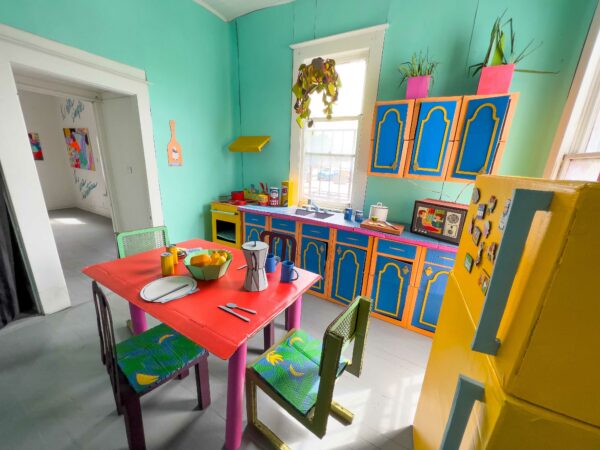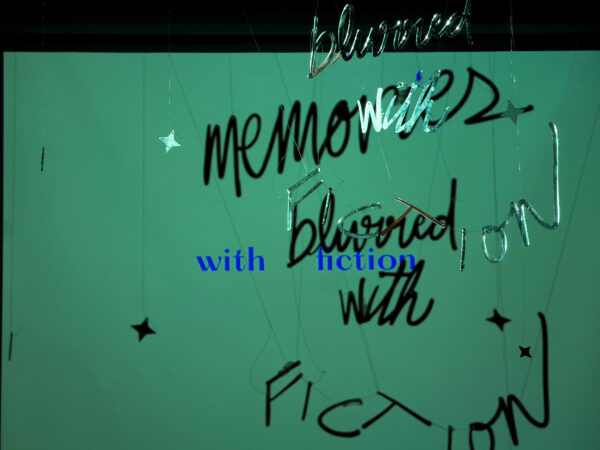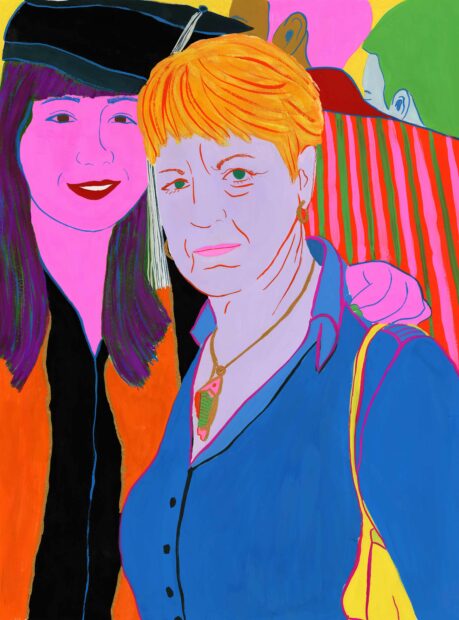Psychologists discuss memory as a fickle thing — specifically, in light of the scientific proof behind its fallibility. What we call “remembering,” psychologists refer to as “reconstructing” a memory, because memory is subject to such influences as personal perception, biases, and the introduction of new information.
Alexandria Canchola’s Yours to Keep, at Presa House Gallery in San Antonio, is named for an album of the same title by Albert Hammond Jr. Yours to Keep communicates sentimentality for the past. This exhibition is an act of keeping a loved one alive through memory, specifically Canchola’s grandmother, Emelina Conception (she often went by Conchita), who died in the summer of 2022.

Alexandria Canchola, installation view of “Yours to Keep,” featuring risograph prints and gouache on paper paintings. Photo: Alexandria Canchola.
Upon entering the gallery, the viewer encounters a hallway of fluorescent risograph prints and brightly colored paintings. The prints fill the walls from floor to ceiling and door frame to door frame, and the six paintings hang on top of them. Canchola made the prints based on the paintings, which are themselves based on photographs and film stills of her grandmother; she is showing the paintings for the first time in this exhibition.
Canchola recognizes that when she remembers her grandmother, her memories are not perfect. The limited, strange color palettes of the artworks speak to this warping of memory. Canchola compares her paintings to her home video compilation, Memories Blurred with Fiction, on view in the next room over. The short clips, from various years, show a young Canchola and her grandmother. In her mind, video captures the truth of a moment better than a memory, a posed photograph, a painting based on a photograph, or a print based on a painting based on a photograph.
The color palette of the paintings is bright, but the fluorescent prints are even brighter. The DayGlo color palette is an unequivocally important element of this body of work because it reminds Canchola of Cuba and the time period in the 1980s and 90s when fluorescent colors were a fashion statement. Canchola also transports us to that time period by using dated clothing and upholstery patterns. Memory mutates in the way that her media proliferates, and she compiled these short clips of home videos to help her remember. Also aiding this is an acrylic mirrored text hanging in the space, reading “memories blurred with fiction,” which cast a shadow upon and reflects back the projected video.

Alexandria Canchola, installation view of “La Cocina,” cardboard and acrylic paint. Photo: Alexandria Canchola.
Canchola also transformed a room of the gallery into a life-size cardboard reproduction of her grandmother’s kitchen from her home in Chicago. For La Cocina, the artist recreated the space based on photographs and memory, complete with appliances, fridge magnets, table fruit, and plants on top of the cabinets. Two coffee cups on the table would have the viewer believe that someone just stood up moments ago. The lines of the installation are crisp, and the colors are bright hues from every color of the rainbow, stylizing what her grandmother’s kitchen actually looked like.
The artist painted what the viewer can assume is an image of a telenovela on the cardboard TV set, aiding in transporting us as viewers to another place and time. La Cocina reflects upon the domestic space of Canchola’s grandmother’s kitchen and her resistance to assimilation. Conchita’s grandmother was 29 years old when she and her husband, Canchola’s grandfather, immigrated from Cuba. She resisted aspects of assimilation that her husband took to easily — she refused to speak English and only cooked Cuban food.

Alexandria Canchola, “Memories Blurred with Fiction,” video and acrylic mirror lettering, duration 38 seconds. Photo: Alexandria Canchola.
Canchola’s grandmother was her role model. But, the more Canchola remembers her grandmother, the more complex she seems. Conchita tried to teach Canchola traditional gender roles, such as how to tend to men and take care of a home. At the same time, Canchola saw her grandmother speak back to her grandfather and resist some of her own gender roles. Through remembering her grandmother, the artist is contemplating the parallel between cultural and domestic submission, both of which she witnessed her grandmother grapple with.
Emelina Conception passed in the summer of 2022. Canchola reflects that, by telling her grandmother’s story, she is expressing how extraordinary Conchita’s life was. Certainly, Conchita was extraordinary, and Canchola says the paintings of Conchita are so brightly colored because her memories are colored by emotion — grief, specifically. Grief makes those memories feel shocking, loud even.
Yours to Keep is on view at Presa House Gallery through November 3, 2023.




